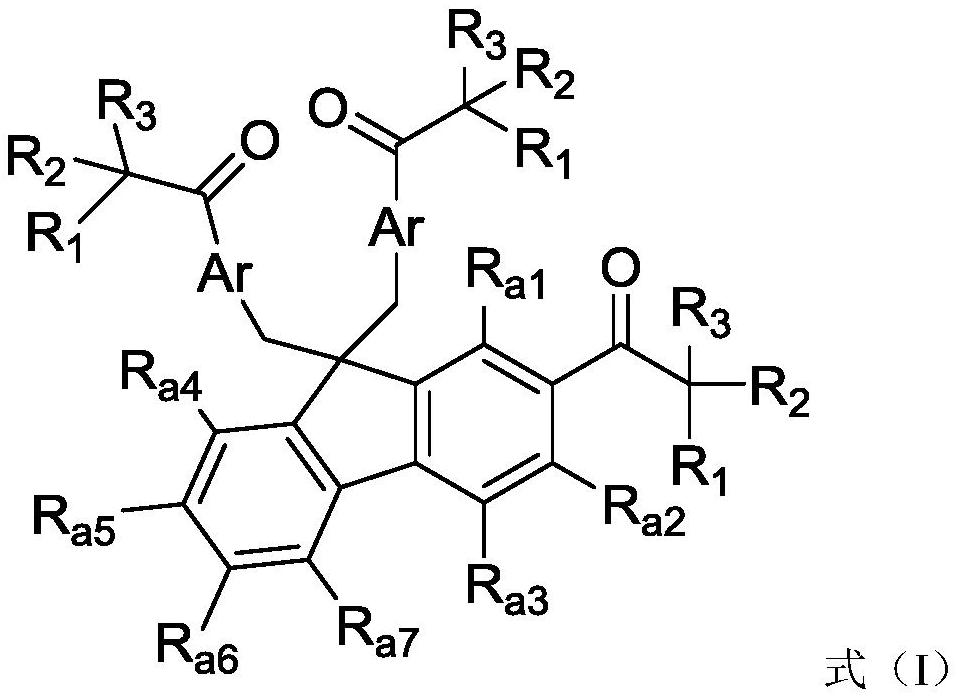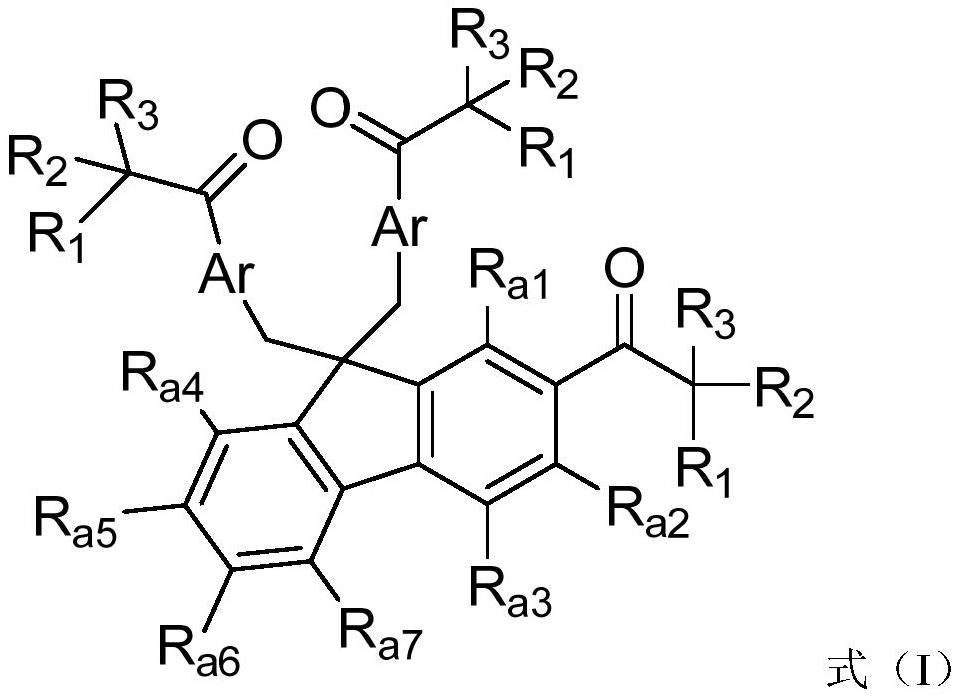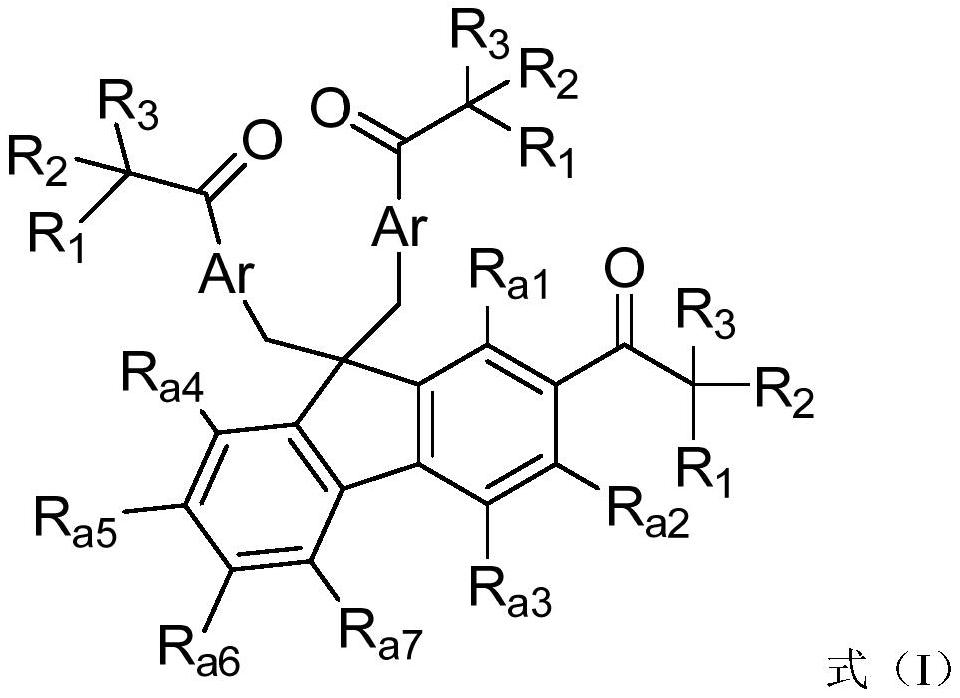Fluorene initiator, photocurable composition containing same, and application thereof
An initiator and light-curing technology, applied in the field of light-curing, can solve the problem of not being able to have zero migration, high sensitivity to yellowing resistance at the same time, and achieve the effect of improving sensitivity, high light curing effect and excellent yellowing resistance.
- Summary
- Abstract
- Description
- Claims
- Application Information
AI Technical Summary
Problems solved by technology
Method used
Image
Examples
preparation example Construction
[0042] Another aspect of the present application also provides a kind of preparation method of above-mentioned fluorene photoinitiator, and this preparation method comprises:
[0043] S1, in the presence of the first organic solvent, intermediate a undergoes a substitution reaction with a halogenated compound to generate intermediate b, and the synthetic route is as follows:
[0044]
[0045] Among them, X 1 is a halogen atom;
[0046] S2, in the presence of a second organic solvent, the Friedel-Crafts reaction of the intermediate b and the halogenated alkanoyl compound is carried out to obtain the intermediate c, and the synthetic route is as follows:
[0047]
[0048] Among them, X 2 and X' are independently selected from halogen atoms;
[0049] S3, hydrolyzing the intermediate c with water to obtain a fluorene-based photoinitiator, or performing a dehalogenation reaction between the intermediate c and a compound containing a non-hydroxyl photoactive group to obtain...
Embodiment 1-16
[0067] Step (1): Preparation of dibenzylfluorene (a1)
[0068]
[0069] Add 400g of dichloromethane, 50g of fluorene, 80g of benzyl chloride and 1g of tetrabutylammonium bromide into a 1L four-necked flask, stir, and under nitrogen protection, add 120g of 50% sodium hydroxide solution dropwise in a water bath at 30°C to control the system The temperature was below 35°C, and the addition was completed in 15 minutes. After the addition, the system was heated to reflux for 8 hours. Samples were taken to detect the complete reaction of the raw materials, and the reaction was stopped, and the temperature was lowered to room temperature. Add 100g of water to the reaction solution, separate the organic layer, wash the organic layer with water 3 times until neutral, evaporate the organic phase to dryness, add 200g of methanol to crystallize, stir and crystallize for 1h, filter, and dry the wet product to obtain off-white Solid 95.8g, yield 92.1%, purity 99.2%.
[0070] The structu...
Embodiment 17-26
[0088] Referring to the synthesis methods of Examples 1-16, compounds 17-26 were synthesized by different preparation methods.
[0089] Synthesis of compound 17:
[0090]
[0091] Add 50 g of toluene, 22 g of dibenzylfluorene trichloroisobutyryl chloride Friedel-Crafts, and 1.32 g of tetrabutylammonium bromide into a 250 mL four-neck flask, stir, add 75 g of 25% sodium hydroxide solution dropwise, and control the temperature of the system at Below 30°C, the addition was completed in 10 minutes, and the system was heated in a water bath at 80°C for 1 hour to stop the reaction. When the temperature of the system drops to room temperature, separate the organic layer, wash the organic layer with 300 g of water until neutral, pour the organic layer into a 250 mL four-neck flask, add 2 g of activated carbon, stir for 1 h, filter, rinse the filter cake with a little toluene, and combine the organic phases , pour the filtrate into a 250mL four-neck flask, distill off the organic s...
PUM
 Login to View More
Login to View More Abstract
Description
Claims
Application Information
 Login to View More
Login to View More - R&D
- Intellectual Property
- Life Sciences
- Materials
- Tech Scout
- Unparalleled Data Quality
- Higher Quality Content
- 60% Fewer Hallucinations
Browse by: Latest US Patents, China's latest patents, Technical Efficacy Thesaurus, Application Domain, Technology Topic, Popular Technical Reports.
© 2025 PatSnap. All rights reserved.Legal|Privacy policy|Modern Slavery Act Transparency Statement|Sitemap|About US| Contact US: help@patsnap.com



